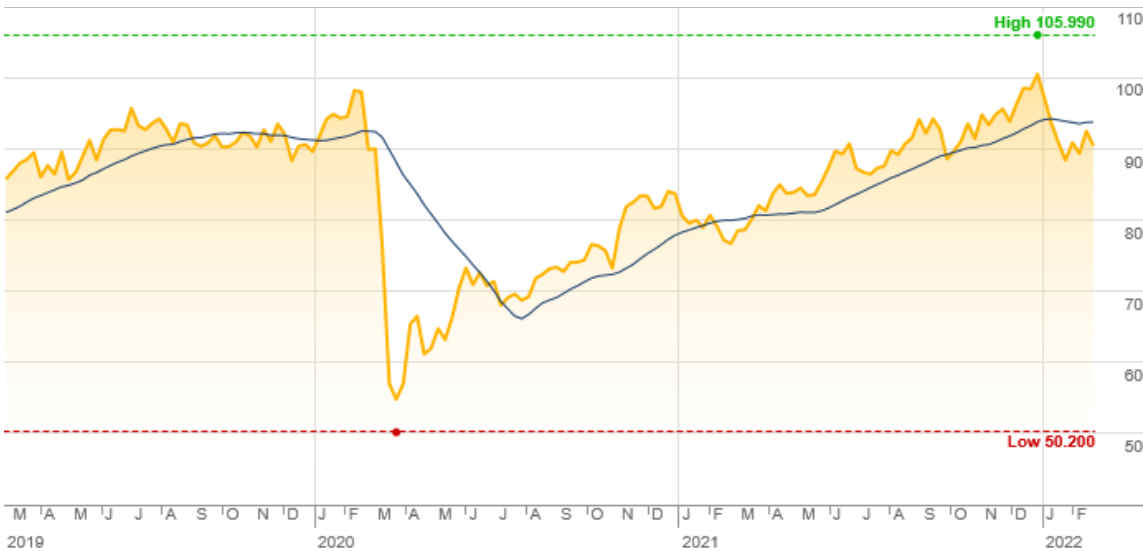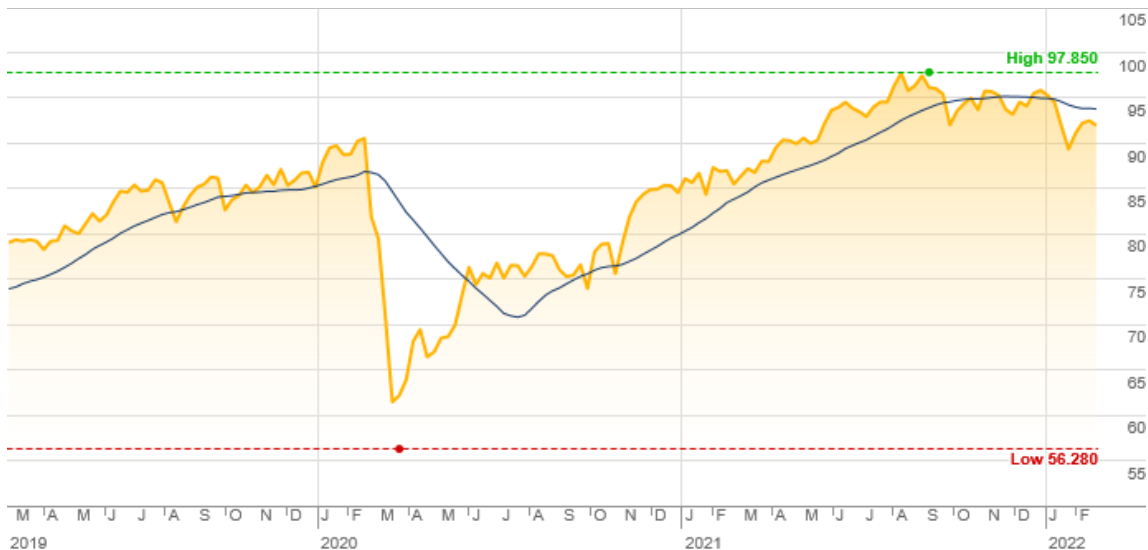Both bonds and equities have lost ground for the year to date. Bonds have weakened in a world of unexpectedly high inflation, which has prompted central banks to start raising interest rates. Equities have suffered as monetary policy looks to tighten more than previously anticipated, surging omicron cases have resulted in a new round of setbacks to production and spending, and the crisis over Ukraine has raised serious geopolitical concerns with potential outcomes that are hard to predict. The outlook is still, at both a global and a domestic level, for economic growth to re-emerge on the other side of peak omicron. The major risks to the outlook are central banks having to raise rates more aggressively again, the potential impact of inflation on corporate profit margins, and the unknowable end point of the Ukraine flashpoint.
Australian & International Property – Review
Although not quite in the league of IT or healthcare stocks, both of which have had large double-digit declines, the A-REITs have been one of the larger sectoral losers for the year to date, and the S&P / ASX200 A-REITs Index has made a capital loss of 9.6%.
Overseas REITs have also been weak, and the FTSE EPRA/NAREIT Global Index in U.S. dollars is down by 6.8%, a shade worse than the 5.5% decline in the MSCI World index. The U.S. market was especially weak, with a 9.6% loss: Ex the U.S., the asset class was down by a relatively modest 2.9%.
Australian & International Property – Outlook
The prime driver of the A-REITs’ weakness looks to have been a change in investors’ expectations about monetary policy. As Morningstar commentary (Feb. 18) said, “The sector was caught up in January’s global sell-off as investors repriced assets in expectation of faster than expected rate hikes in the US and Australia. Higher rates hit REIT earnings by increasing debt payments in the highly leveraged sector.
They also squeeze valuations by decreasing the value of future earnings, a similar dynamic seen in January’s technology sell-off”. Another contributory factor has been the sheer scale of omicron cases. This has raised issues about immediate performance – according to property management software company Re-Leased, national rent collection in December was only 81% for retail property, 84% for industrial, and 86% for offices and likely has weakened further since – as well as rekindling longer-term concerns over the future of the office and of brick-and-mortar retail. The long-term structural issues will not go away, but with the reassessment of interest rates out of the way, and as a post-omicron recovery comes closer, the A-REITs may look a better prospect as a defensive option.
Internationally, market sentiment appears to be improving. The latest (December ’21 quarter) survey of global commercial property run by the Royal Institution of Chartered Surveyors, or RICS, showed that investment demand had picked up during the quarter, and expectations about capital returns have improved, albeit with a pronounced sectoral tiering. Prime industrial and data centres are very much in favour – “A constant theme in much of the anecdotal feedback does appear to be the failure of the supply of new logistics facilities to keep pace with growing demand” – and multifamily residential and aged-care facilities are also expected to do well, but the outlook for secondary offices and secondary retail remains depressed, with expectations of further capital losses. For the right sectors, the outlook is reasonably good, but the asset class remains vulnerable to further interest-rate surprises, particularly in the U.S. where there is a real risk that the Fed’s scale of tightening may spring another revaluation reassessment. It does not help that only 10% of the RICS respondents believe that property in their market could be described as cheaply valued.

Australasian Equities — Review
Australian shares have weakened, but relatively modestly by global standards, and for the year to date, the S&P / ASX200 Index is down by 3.2%. The sectoral patterns have mirrored those overseas, notably the sharp sell-off of tech stocks, with the local IT index down by 18.6%, and the strength of commodity producers, with the local miners up 6.5%. The banks have also held up in a difficult market, and the financials ex the A-REITs are narrowly up for the year, by 0.6%. Consumer-oriented stocks have weakened, with consumer staples down by 8.7% and consumer discretionary by 6.0%.
Australasian Equities — Outlook
There are strong crosscurrents in Australia affecting the outlook for corporate performance. On the plus side, it is boom time again for commodity exporters, while on the downside, many companies face intense input cost pressures. The reporting season currently underway is likely to show a very mixed bag of results, differentiated by how well companies have been able to manage their profit margins as costs
have soared. In the interim, omicron is clearly having a major near-term impact: The IHS Markit indicator of overall economic activity in January showed that “Both manufacturing and service sectors output declined in January amid the surge in COVID-19 infections”. The most recent (December ’21) NAB business survey also found that “Business confidence fell sharply in December as the spread of the Omicron variant threatened to dampen the economy’s post-lockdown momentum”.
But better business conditions look to be coming into view. Commenting on the surprisingly strong jobs report for January – 12,900 more jobs, and unemployment steady at 4.2%, all in the middle of the omicron outbreak – CommSec said that “with the economy rebounding, confidence returning and disruptions to the labour market abating as Omicron cases peak, Commonwealth Bank (CBA) Group economists expect wages and inflation growth to accelerate further in the coming months”. A similar conclusion emerged from the latest (January) Westpac / Melbourne Institute leading indicator, which signalled that “the growth outlook has improved with above trend growth over the next three to nine months likely.
While Westpac expects that the contraction in spending in January due to the omicron variant will see zero growth in GDP in the March quarter, the economy is likely to bounce back strongly over the remainder of 2022, registering a solid 5.5% growth rate for the year overall”. Equity markets may start to feel more comfortable about the outlook, with the provisos that the RBA may yet be prodded into earlier
interest-rate hikes than the market currently expects, that there will be winners and losers at an individual stock level from the current inflationary pressures, and that geopolitics may still override any domestic upturn.

International Equities — Review
World shares continue to have a hard time. Although there has been some recovery from its recent low point on Jan. 26, the MSCI World Index of developed markets in U.S. dollars is down by 5.5% for the year to date. The U.S. market has continued to have a strong impact. In 2021, it led global shares up, and in 2022 it has led them down, with the S&P 500 down 6.2% and the Nasdaq down 9.6%. Ex the U.S., the MSCI World is still down but by a smaller 3.2%. Japan (Nikkei down 6.6% in yen) and Europe as a whole (FTSE Eurofirst 300 down 3.3% in euros) have been weak, while the U.K. is a rare example of a major market ahead for the year, with the FTSE 100 up 3.0% in sterling terms.
Emerging markets have been relatively unscathed, and year to date the MSCI Emerging Markets index in U.S. dollars is down by a marginal 0.2%, as is its core ‘BRIC’ (Brazil, Russia, India, China) component. All of the performance is down to Brazil: The MSCI Brazil index is up by 18.7% in dollars on the back of strong investor interest in Brazilian commodity producers, and it has offset modest declines in the other BRIC members.
International Equities — Outlook
World equities are struggling with, if not the perfect storm, certainly a strong gale of headwinds: the disruptive effects of omicron, the potential impact of higher interest rates on corporate profitability and equity valuations at a time when valuations were on the expensive side to start with, the risk that input cost inflation will erode profit margins for some companies or sectors, and the ongoing geopolitical uncertainty over a potential invasion of Ukraine, after an extended period where geopolitical risks had been quiescent.
The immediate effect of omicron can be seen in the January readings from the J.P. Morgan Global Composite Index of economic activity: The world economy is still growing and has now managed 19 months in a row of recovery from the initial COVID-19 blow, but the rate of growth has dropped significantly to the slowest in 18 months due to, as J.P. Morgan said, “significant virus deterioration”. But omicron, even if it is front and centre of the news stream now, may be leading investors to take an unduly pessimistic view of the underlying economic backdrop for shares. Hopefully, the employees off sick, and the other disruptions and restrictions that omicron is currently causing, will ease as the year
goes on. The latest forecast from the big multilateral institutions, January’s World Economic Outlook from the IMF, is still picking that, despite the latest pandemic setbacks, 2022 and 2023 will be solid years for the world economy, with GDP growth expected to be 4.4% this year and 3.8% in 2023. The latest (January) survey of institutional investors run by Bank of America Merrill Lynch, or BAML, showed that the professionals are still of the view that the world economy will be supportive for equities. Respondents are “showing faith in the global reopening story”, as Bank of America summarised it. They have moved even more overweight to equities and see a very low risk of a global recession in the coming 12 months.
Within this overall optimistic view, there have, however, been pronounced sectoral shifts: The global reopening trade has encouraged the big fund managers to increase their allocations to more cyclical sectors like the banks and sharply away from growth sectors like tech, and they are riding the current inflationary pressures with a big bet on commodities, which are now at an all-time high level of tactical allocation. Even with this underlying backdrop of growth, however, risk remains high. The IMF said that “Risks to the global baseline are tilted to the downside. The emergence of new COVID-19 variants could prolong the pandemic and induce renewed economic disruptions. Moreover, supply chain disruptions, energy price volatility, and localized wage pressures mean uncertainty around inflation and policy paths is high. As advanced economies lift policy rates, risks to financial stability and emerging market and developing
economies’ capital flows, currencies, and fiscal positions—especially with debt levels having increased significantly in the past two years—may emerge. Other global risks may crystallize as geopolitical tensions remain high and the ongoing climate emergency means that the probability of major natural disasters remains elevated”.
In the immediate future, the two that look to have the greatest potential for ongoing weakness or volatility are interest rates and Ukraine. The BAML survey respondents expected three rate rises from the Fed this year. That looks on the low side, and there may be ongoing questioning of equity valuations if rates rise more than currently expected. And the Ukraine outlook remains unknowable: At the time of writing, there were conflicting stories about whether Russia had or had not reduced the number of troops near the Ukraine border. It continues to have the potential to produce an unpleasant shock.
Performance periods unless otherwise stated generally refer to periods ended Tuesday, Feb. 15, 2022.
Reproduced from Morningstar Research Feb 18, 2022, Economic Update: Australia

Recent Comments